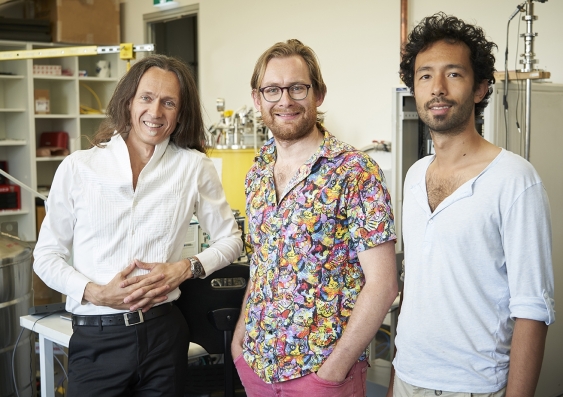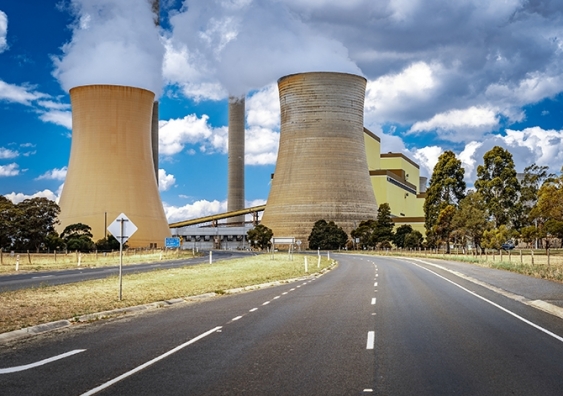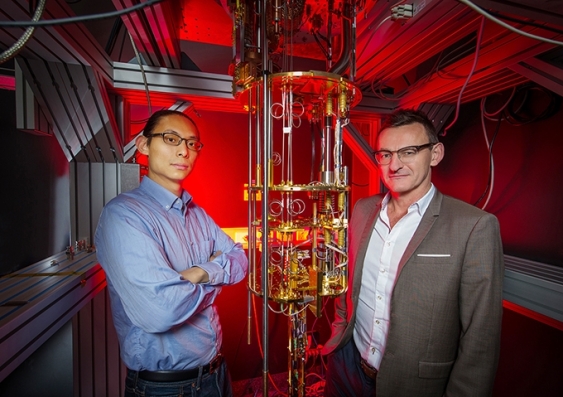Calamities, computers and CO2 – our most-read engineering stories for 2020
Quantum computers, making greenhouse gases useful, COVID-19 infection from droplet spread and water security were some of the most popular engineering stories in 2020.
Quantum computers, making greenhouse gases useful, COVID-19 infection from droplet spread and water security were some of the most popular engineering stories in 2020.

It’s no surprise that some of the most-read engineering stories for 2020 are focused on the most obvious threats this year – bushfires and the COVID-19 pandemic. But stories about other global challenges were also popular, such as water security, advances in quantum computing and ingenious ways to convert harmful greenhouse gases back into something useful.
Let’s take a look at the top 5 topics that interested readers this year:

Professor Andrea Morello, Dr Vincent Mourik and Dr Serwan Asaad. Photo: Lee Henderson/UNSW
This story about a happy accident in the lab that led to a ‘eureka moment’ in quantum computing was not only the top engineering story for 2020, but ranked No. 2 overall in the UNSW Newsroom’s most read stories.
Professor Andrea Morello and his team of researchers set out to perform nuclear magnetic resonance on a single atom of antimony to explore the boundary between the quantum and the classical worlds – a project driven purely by curiosity. But they soon realised something was very wrong.
“The nucleus behaved very strangely, refusing to respond at certain frequencies, but showing a strong response at others,” recalls Dr Vincent Mourik.
“This puzzled us for a while, until we had a ‘eureka moment’ and realised that we were doing electric resonance instead of magnetic resonance.”
Amazingly, the trio had cracked a longstanding problem set by pioneer of magnetic resonance, Nobel Laureate Nicolaas Bloembergen way back in 1961 – but were completely unaware of their feat.
And in another serendipitous quirk of fate, after this story was published on the Newsroom website, the researchers discovered their study announcing the cracking of this 58-year-old mystery was published on what would have been Nicolaas Bloembergen’s 100th birthday.

The technology to convert carbon dioxide into industrial precursor chemicals could be retrofitted to coal-fired power plants. Photo: Shutterstock
A couple of up-and-coming chemical engineers showed that turning a greenhouse gas into useful products is as easy as playing with Lego.
The duo developed new technology that helps convert harmful carbon dioxide emissions into chemical building blocks to make useful industrial products like fuel and plastics.
And if adopted on a large scale, the process could give the world breathing space as it transitions towards a green economy.
The researchers – Dr Rahman Daiyan and Dr Emma Lovell from UNSW’s School of Chemical Engineering – showed that by making zinc oxide at very high temperatures using a technique called flame spray pyrolysis, they can create nanoparticles which act as the catalyst for turning carbon dioxide into ‘syngas’ – a mix of hydrogen and carbon monoxide used in the manufacture of industrial products.
The researchers say this method is cheaper and more scalable to the requirements of heavy industry than what is available today. The new technology could also close the carbon loop when applied to industrial processes that create harmful greenhouse gases.
“Waste CO2 from say, a power plant or cement factory, can be passed through an electrolyser, and inside we have our flame-sprayed zinc oxide material in the form of an electrode,” says Dr Rahman.
“When we pass the waste CO2 in, it is processed using electricity and is released from an outlet as syngas in a mix of CO and hydrogen,” he says.

Dr Henry Yang and Professor Andrew Dzurak with a dilution refrigerator designed to keep qubits operating at extremely cold temperatures. Photo: UNSW Sydney
Another popular quantum computing story told about a proof-of-concept that promises warmer, cheaper and more robust quantum computing that can be manufactured using conventional silicon chip foundries.
Most quantum computers being developed around the world will only work at fractions of a degree above absolute zero. That requires multi-million-dollar refrigeration and as soon as you plug them into conventional electronic circuits they’ll instantly overheat.
But researchers led by Professor Andrew Dzurak at UNSW Sydney addressed this problem.
“Our new results open a path from experimental devices to affordable quantum computers for real world business and government applications,” says Professor Dzurak.
The researchers’ proof-of-concept quantum processor unit cell, on a silicon chip, works at 1.5 Kelvin – 15 times warmer than the main competing chip-based technology being developed by Google, IBM, and others, which uses superconducting qubits.
“This is still very cold, but is a temperature that can be achieved using just a few thousand dollars’ worth of refrigeration, rather than the millions of dollars needed to cool chips to 0.1 Kelvin,” explains Dzurak.
“While difficult to appreciate using our everyday concepts of temperature, this increase is extreme in the quantum world.”
Quantum computers are expected to outperform conventional ones for a range of important problems, from precision drug-making to search algorithms. Designing one that can be manufactured and operated in a real-world setting, however, represents a major technical challenge.
The UNSW researchers believe that they have overcome one of the hardest obstacles standing in the way of quantum computers becoming a reality.

Researchers used an LED lighting system with a high-speed camera to capture the spread of germs from coughing and sneezing. Image from Shutterstock
Ewww! Who knew a human could expel so many droplets just by talking!
A team of engineers who were expert in flow dynamics joined forces with UNSW’s leading COVID-19 experts to film in great detail, a person talking, coughing and sneezing, while wearing home-made cloth masks, surgical masks, and wearing no mask at all.
The results showed that surgical masks were the best at keeping the expulsion of droplets to a minimum, and that two-layers of cloth masks were better than one.
In an op ed piece also published in The Conversation, the authors argued that because COVID-19 could be transmitted by asymptomatic individuals, it made sense for the public to wear cloth masks – the more layers, the better – to lower the risk of community transmission of COVID-19.
Written at the time when the Victorian government had just mandated the wearing of masks in Melbourne in response to the rapid spread of COVID-19, the authors supported the public wearing of cloth masks.
“In practice, we don’t yet know which has a greater effect — wearing masks to prevent infected people spreading to others or protecting well people from inhaling infected aerosols. Probably both are equally important,” the authors wrote.
“In Missouri, two infected hairdressers kept working while infectious, but wore a mix of cloth and surgical masks, as did their 139 clients. No client was infected.
“However, one hairdresser infected her household family members, as she did not wear a mask at home, and neither did her family.
“This is reassuring evidence that infection risk is reduced when everyone wears masks.”

Maintaining drinking water quality is a major challenge for water managers during and after bushfires. Photo: Shutterstock
There was an obvious toll when the bushfires ravaged Australia last summer – human and animal lives, property, millions of hectares of bushland burnt – but water quality may be a lesser-known casualty of the fires.
In some areas of NSW, drinking water treatment plants were physically damaged by fire or impacted by fire-related power outages, causing a loss of drinkable tap water.
There were fears that a reduction in water quality could affect metropolitan areas, as ash and sediment washed into major water catchments such as Warragamba Dam.
“Fires have severely and extensively burnt major drinking water catchments for Sydney and the Shoalhaven region in NSW,” said Professor Stuart Khan, Professor in the School of Civil & Environmental Engineering at UNSW Sydney.
“The loss of trees and groundcover has made the soil more vulnerable to erosion. When the next big rainfall event comes along, runoff will wash a lot of that ash into waterways and dams.”
This is exactly what happened in Eden and Boydtown on NSW’s south coast. Residents there received urgent alerts to boil water alert after a loss of power affected chlorination facilities at Ben Boyd Dam. The alert provided instructions on how residents without electricity can clean water using unscented household bleach.
“There is a risk that if people are unable to boil water or don't get the alert to boil water, it could lead to some waterborne disease,” Professor Khan said.